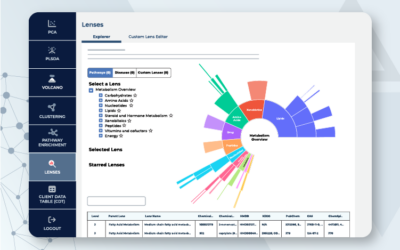Bile acids play a critical role in human digestion, solubilizing lipids and facilitating their absorption from the small intestine into the bloodstream. While the liver produces two kinds of bile acids, the intestinal microbiome can transform any unabsorbed bile acids into secondary bile acids. Secondary bile acids in blood and fecal matter may act as useful biomarkers for a variety of diseases. The ability to profile these bile acids, therefore, represents an important step to better understanding the relationship between the gut microbiome and intestinal physiology.
What are Bile Acids?
Bile acids are water-soluble, amphipathic molecules generated as the end-product of cholesterol metabolism. Humans produce two primary bile acids, cholic acid and chenodeoxycholic acid (CDCA).1 These molecules, which consist of a rigid steroid nucleus and a short aliphatic side chain, comprise the key components of bile. Primary bile acids are immediately conjugated with glycine or taurine, rendering them soluble in the small intestine.2 This enables bile acids to accomplish their digestive functions.
How do Bile Acids Aid Digestion?
Bile acids play several important physiological roles in the small intestine. Bile acids can form micelles, small aggregates that encapsulate lipids and facilitate their absorption into the bloodstream. Bile acids also absorb fat-soluble vitamins—vitamins A, D, E, and K—in the same manner. They also regulate metabolism by functioning as hormones, interacting with both the Farnesoid X receptor (FXR)3 and the bile acid membrane receptor TGR54 in the small and large intestines. When activated, these receptors play important roles in metabolic function by regulating insulin sensitivity and lipid metabolism.5,6
Bile Acids and the Gut Microbiome
Ninety-five percent of the 12 to 18 grams of bile acids that enter the small intestine are reabsorbed into the bloodstream and recycled in the liver. The remaining 5% enter the large intestine, where the gut microbiome deconjugates, dehydrogenates, and dehydroxylates them.7 This generates a diverse pool of over 50 secondary bile acids that reflects and impacts the gut microbial community.8 These bile acids also interact with intestinal cell receptors to regulate several metabolic pathways9 and the gut-brain axis.10 With bile acids playing a dual role in shaping microbiome composition and gut function, bile acids can serve as important biomarkers of health and disease.
The Microbiome and Metabolomics
Metabolomics is fast becoming the preferred field for studying biological states through biomarker identification. The study of small molecules in living organisms provides a direct indication of a cell’s state and biochemical activity. The study of the interaction between microbial and host metabolites—including secondary bile acids—is proving to be a powerful tool in pre-clinical research.
Microbiome researchers have demonstrated, for example, that fecal and plasma metabolites are better predictors of gut microbiome diversity than clinical laboratory tests.11 Additionally, changes in sulfur metabolism and bile acid abundance have been shown to be robust biomarkers of motor symptom severity among Parkinson’s disease patients.12 Similarly, increased concentrations of the secondary bile acid, deoxycholic acid, have been reported as a biomarker of Alzheimer’s disease severity.13
Introducing Metabolon’s Microbiome Portfolio and Bile Acids Targeted Panel
Metabolon has created a suite of tools built off of Metabolon’s decades of experience across thousands of metabolomics studies to help you maximize the discovery potential of your microbiome research projects. Our Bile Acids Targeted Panel has been designed specifically to advance pre-clinical research identifying bile-acid related biomarkers in digestive, metabolic, and neurological health. This panel has already been successfully used to confirm the successful engraftment microbiome therapeutic candidate SER-287 in patients with mild-to-severe ulcerative colitis.14 Contact us today to learn more about our Bile Acids Targeted Panel and how Metabolon can help you advance your research at each phase of drug discovery and development.
Contact us today to learn more.
References
- Staels B, Fonseca VA. Bile Acids and Metabolic Regulation. Diabetes Care. 2009;32(Suppl 2):S237-S245. doi:10.2337/dc09-S355
- Hofmann AF, Mysels KJ. Bile acid solubility and precipitation in vitro and in vivo: the role of conjugation, pH, and Ca2+ ions. J Lipid Res. 1992;33(5):617-626.
- Makishima M, Okamoto AY, Repa JJ, et al. Identification of a nuclear receptor for bile acids. Science. 1999;284(5418):1362-1365. doi:10.1126/science.284.5418.1362
- Kawamata Y, Fujii R, Hosoya M, et al. A G protein-coupled receptor responsive to bile acids. J Biol Chem. 2003;278(11):9435-9440. doi:10.1074/jbc.M209706200
- Cariou B, van Harmelen K, Duran-Sandoval D, et al. The farnesoid X receptor modulates adiposity and peripheral insulin sensitivity in mice. J Biol Chem. 2006;281(16):11039-11049. doi:10.1074/jbc.M510258200
- Watanabe M, Houten SM, Wang L, et al. Bile acids lower triglyceride levels via a pathway involving FXR, SHP, and SREBP-1c. J Clin Invest. 2004;113(10):1408-1418. doi:10.1172/JCI21025
- Winston JA, Theriot CM. Diversification of host bile acids by members of the gut microbiota. Gut Microbes. 2020;11(2):158-171. doi:10.1080/19490976.2019.1674124
- Tian Y, Gui W, Koo I, et al. The microbiome modulating activity of bile acids. Gut Microbes. 2020;11(4):979-996. doi:10.1080/19490976.2020.1732268
- Setchell KD, Lawson AM, Tanida N, Sjövall J. General methods for the analysis of metabolic profiles of bile acids and related compounds in feces. J Lipid Res. 1983;24(8):1085-1100.
- Monteiro-Cardoso VF, Corlianò M, Singaraja RR. Bile Acids: A Communication Channel in the Gut-Brain Axis. Neuromolecular Med. 2021;23(1):99-117. doi:10.1007/s12017-020-08625-z
- Wilmanski T, Rappaport N, Earls JC, et al. Blood metabolome predicts gut microbiome α-diversity in humans. Nat Biotechnol. 2019;37(10):1217-1228. doi:10.1038/s41587-019-0233-9
- Hertel J, Harms AC, Heinken A, et al. Integrated Analyses of Microbiome and Longitudinal Metabolome Data Reveal Microbial-Host Interactions on Sulfur Metabolism in Parkinson’s Disease. Cell Reports. 2019;29(7):1767-1777.e8. doi:10.1016/j.celrep.2019.10.035
- MahmoudianDehkordi S, Arnold M, Nho K, et al. Altered bile acid profile associates with cognitive impairment in Alzheimer’s disease-An emerging role for gut microbiome. Alzheimers Dement. 2019;15(1):76-92. doi:10.1016/j.jalz.2018.07.217
- Henn MR, O’Brien EJ, Diao L, et al. A Phase 1b Safety Study of SER-287, a Spore-Based Microbiome Therapeutic, for Active Mild to Moderate Ulcerative Colitis. Gastroenterology. 2021;160(1):115-127.e30. doi:10.1053/j.gastro.2020.07.048






